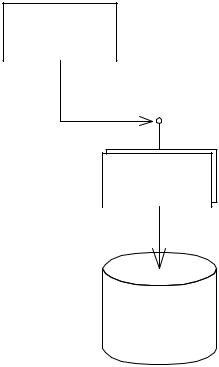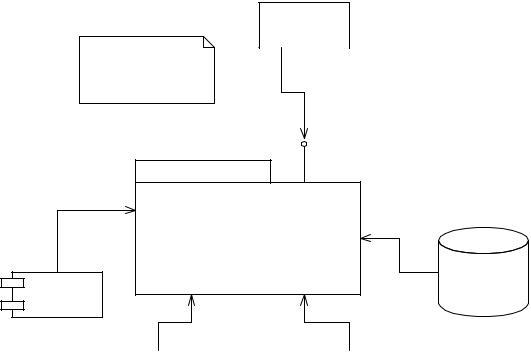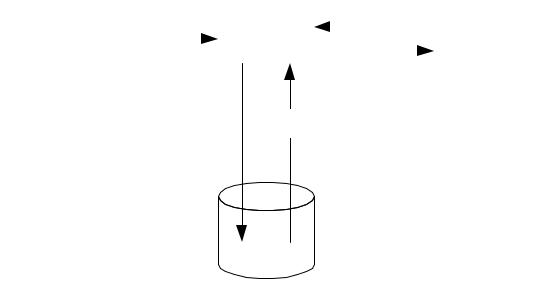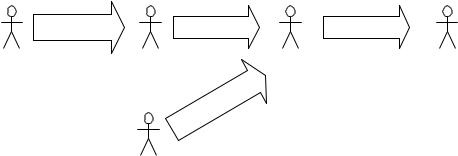
Mastering Enterprise JavaBeans™ and the Java 2 Platform, Enterprise Edition - Roman E
..pdf
Server-side Component Architectures |
|
35 |
Client
JDBC API
JDBC Driver
Relational
Database(s)
Figure 1.13 Java Database Connectivity.
Java Transaction API (JTA) and Java Transaction Service (JTS)
A transaction is a unit of work that makes a set of guarantees about its execution. For example, one guarantee that transactions give you is that any code executing within the scope of a transaction is guaranteed either to all be executed or to not execute at all. Transactions are one of the most useful constructs EJB brings to the table, and they are required to maintain a consistent system state. Transactions allow for multiple users to be modifying the same data, yet each to be isolated from one another—in essence, a very sophisticated form of synchronization.
To facilitate transactions, Sun Microsystems has produced two APIs: the Java Transaction API (JTA) and the Java Transaction Service (JTS). These two products embody how transactions can be performed in Java (see Figure 1.14).
JTA is a high-level transaction interface that your applications use to control transactions. You need to understand how the JTA works in order to perform transactions in Java.
Go back to the first page for a quick link to buy this book online!

36 |
|
M A S T E R I N G E N T E R P R I S E J A V A B E A N S |
Client
We learn more about how transactions work in Chapter 10.
Java Transaction
API
Java Transaction
Service
Transaction
Coordinator
Persistent Stores
|
|
Transaction |
|
|
|
Resource |
|
|
|
|
|
||
|
|
|
|
|||
|
|
Manager(s) |
|
|
|
Manager(s) |
|
|
|
|
|
|
|
Figure 1.14 Java Transaction API and Java Transaction Service.
JTS is a set of low-level transaction interfaces that EJB uses behind the scenes (your client code doesn’t directly interact with JTS). JTS makes it possible for multiple vendors to collaborate when performing transactions in a distributed, heterogeneous environment. JTS is based on the Object Transaction Service (OTS), which is part of CORBA.
Enterprise JavaBeans strictly depends on JTA, but it does not depend on JTS. As an application programmer, you may need to learn the JTA for performing advanced transaction control. We’ll go into more detail about the JTA, as well as touch on the JTS, in Chapter 10.
Java Messaging Service (JMS)
A messaging service allows for distributed objects to communicate in an asynchronous, reliable manner. By passing messages asynchronously rather than synchronously, the overall system scalability is increased. Processes can respond
Go back to the first page for a quick link to buy this book online!

Server-side Component Architectures |
|
37 |
to messages at their leisure, and they could potentially be offline when a message is initially sent.
You can perform asynchronous messaging by using an Enterprise Messaging Product (these are grouped together under the title Message Oriented Middleware, or MOM). These messaging systems are very proprietary. As with directory services, choosing a MOM vendor often entails binding yourself to a particular vendor.
Sun Microsystems has released an API called the Java Messaging Service (JMS) that can be used as a portable messaging service. By using a common API, distributed objects can communicate in a scalable, transactional, fault-tolerant, asynchronous, and, most important, vendor-independent manner. The JMS is illustrated in Figure 1.15.
Unfortunately, the EJB 1.1 specification does not define the integration points necessary to fully leverage JMS in EJB components, so we do not explicitly cover JMS in this book. The EJB 2.0 specification is expected to address this outstanding issue.
Java Servlets and Java Server Pages (JSPs)
Servlets are networked components that you can use to extend the functionality of a Web server. Servlets are request/response oriented in that they take
|
|
|
|
|
|
|
|
|
|
3: Get |
|
|
|
|
|
|
1: Put |
|
|
Java |
|
|
|
Message |
|
|
|
||
|
|
Message |
|
|
|
|
|
5: Give |
|
|
|
|
||
Object A |
|
|
|
Messaging |
|
|
|
|
Object B |
|||||
|
|
|
|
|
|
|
message |
|
|
|
||||
|
|
|
|
|
|
|
|
|
||||||
|
|
|
|
|
Service |
|
|
|
|
|
||||
|
|
|
|
|
|
|
|
|
|
|
|
|
||
|
|
|
|
|
|
|
|
|
|
|
|
|
|
|
4: Retrieve
Message
2: Store message
Figure 1.15 Java Messaging Service.
Go back to the first page for a quick link to buy this book online!
38 |
|
M A S T E R I N G E N T E R P R I S E J A V A B E A N S |
requests from some client host (such as a Web browser) and issue a response back to that host. This makes servlets ideal for performing Web tasks, such as rendering an HTML interface to an e-commerce catalog. Note, however, that servlets are not necessarily tied to Web servers, and they can be used as generic request/response-oriented components. Servlets differ from EJB components in that the breadth of server-side component features that EJB offers is not readily available to servlets. Servlets are much better suited to handling simple request/response needs, and they do not require sophisticated management by an application server.
Java Server Pages (JSPs) are very similar to servlets. In fact, JSP scripts are compiled into servlets. The largest difference between JSP scripts and servlets is that JSP scripts are not pure Java code, but they are much more centered around look- and-feel issues. You would use JSP when you want the look and feel of your deployment to be physically separate and easily maintainable from the rest of your deployment. JSPs are perfect for this, and they can be easily written and maintained by non-Java savvy staff members (JSPs do not require a Java compiler).
We illustrate connecting servlets with EJB components in Chapters 12 and 15.
Java IDL
As we’ve mentioned, CORBA is a massive middleware effort developed by the Object Management Group (OMG). The OMG represents hundreds of companies that have invested in this cross-platform architecture. CORBA is language independent; it doesn’t matter what you code your programs in with CORBA, so long as CORBA supports the language in which you’re developing.
Java IDL is an implementation of the CORBA specification in Java, and it allows for connectivity and interoperability with heterogeneous objects. Java IDL is one specific implementation of CORBA; there are many such implementations. And while Java IDL does not implement everything that is specified in CORBA, Java IDL ships free with the Java 2 platform. We cover Java IDL briefly in Chapter 11.
JavaMail
Sun’s JavaMail API allows your applications to use e-mail capabilities. The JavaMail object model is quite simple to use, and it is easy to pick up if you’ve been programming with Java (it follows similar methodologies, such as exception handling and event handling). Like most of the other J2EE APIs (JNDI comes to mind), JavaMail defines a set of interfaces to which you write your application code, and those interfaces shield your code from the specific protocols or mail service implementations used. Your Internet mail code effectively becomes portable across platforms, as well as across mail protocols. JavaMail also ships
Go back to the first page for a quick link to buy this book online!

Server-side Component Architectures |
|
39 |
CORBA and EJB
EJB and CORBA share much functionality—many of the qualities of service that EJB offers are also in CORBA. In fact, you can think of EJB as CORBA plus standards for how your components should be written and managed, increasing productivity.
A massive amount of development effort has gone into CORBA. It would be a shame if Enterprise JavaBeans did not integrate with CORBA. Fortunately, Sun Microsystems and the OMG are both supporting EJB/CORBA interoperability, and they have produced standards that will allow that to happen.
The EJB/CORBA mapping specification, along with RMI-IIOP, lifts the restriction that EJB must be solely Java-based. You can expose EJB components as CORBA objects, which generalizes EJB and makes it well suited for cross-language interoperability. This is a very powerful idea, which we’ll examine further in Chapter 11.
with a set of convenience classes to simplify application development, and it also ships with a few service providers that implement the most popular mail protocols. JavaMail depends on the JavaBeans Activation Framework (JAF) to encapsulate message data and to handle interactions with that data. This makes J2EE depend on JAF, meaning that a vendor that provides a J2EE product must provide JAF as well.
Connectors
J2EE is being enhanced to include integration with existing information systems via connectors. A connector is a vendor-specific bridge that links an existing system to the Java 2 Platform, Enterprise Edition. Using connectors, you can write cross-platform, cross-vendor J2EE code that leverages existing investments. These existing investments could be Enterprise Resource Planning (ERP) systems, message-oriented middleware (MOM) systems, mainframe systems such as IBM’s CICS and IMS, BEA’s Tuxedo, or existing legacy databases.
Connectors are useful because they will automatically manage the hairy details of middleware navigation to existing systems, such as handling transaction and security concerns. Sun’s connector specification should also provide standard interfaces that vendors can write to, enabling you to plug any connector into any J2EE product, which means your legacy access code should be portable across application servers. Note that connectors are different from the other J2EE APIs because connectors are very vendor-specific (the API for an IBM CICS connector would most certainly be different from an SAP R/3 connector).
When Sun Microsystems completes the connector specification (most likely not until well into the year 2000), you should see a connector marketplace emerge,
Go back to the first page for a quick link to buy this book online!

40 |
|
M A S T E R I N G E N T E R P R I S E J A V A B E A N S |
where connector providers such as IBM, BEA, SAP, Baan, Peoplesoft, or other companies provide J2EE connectors to specific existing systems. Until then, you have several choices for connecting to existing information systems, such as using a proprietary connector solution (SAP will likely ship one before J2EE connectors are finalized), using CORBA to integrate with existing systems, or growing an in-house solution.
The Extensible Markup Language (XML)
The Extensible Markup Language (XML) is a universal standard for structuring content in electronic documents. XML is extensible in that businesses can use XML to craft new structure to their documents as needed. The XML standard does not suffer the version control problems of other markup languages such as HTML because there are no predefined tags in XML—rather, you define your own tags for your business needs. This makes XML the ideal document format for transferring business data electronically, and it has a wide variety of other applications as well. We cover XML in Appendix C.
J2EE uses XML in several ways. Java Server Pages (JSPs) use XML as a data document format for authoring Web script. EJB 1.1 uses XML to describe components, which we cover in Appendix D. Sun may also mandate that J2EE products make APIs available for applications to parse and interpret XML documents as well.
Summary
By now, you should have a solid idea about the issues involved in server-side computing. You should also understand why a server-side component architecture is needed and why it provides the ability to rapidly develop applications without having to write complex middleware services. You’ve also seen why the J2EE was invented, what the J2EE value proposition is, and the technologies behind J2EE.
So far, we’ve taken a snapshot of the various APIs that J2EE encompasses. We’re just getting started, so hang in there! There are many more interesting concepts to learn ahead.
Go back to the first page for a quick link to buy this book online!

C H A P T E R2
Enterprise JavaBeans Overview
hapter 1 introduced the motivation behind creating the EJB component archi- Ctecture and the J2EE development platform for multi-tier deployments. In this chapter, we’ll dive into EJB in detail, including the specific benefits EJB products offer to server-side components. This chapter will remain at a fairly high
level, reserving the programming details of EJB for Part II.
As we alluded to in Chapter 1, Enterprise JavaBeans takes a divide-and-conquer approach to server-side computing. In fact, the EJB standard contracts allow for a collaboration of six different parties. Each of these parties is an expert in its own field and is responsible for a key part of a successful Enterprise JavaBeans deployment. Because each party is a specialist, the total time required to build an enterprise-class deployment is significantly reduced. This chapter begins with a discussion of the distinct role that each of these parties undertakes.
You’ll then learn about the physical parts of an EJB deployment, including the following:
■■What is an enterprise bean? You’ll see the types of beans available, and you’ll learn about the appropriate times to use them.
■■What are the responsibilities of an EJB server and container? You’ll learn about the specific middleware services the EJB server and container provide to EJB components.
This is a perfect chapter for people in a hurry who want to know some details about how EJB works. Whether you’re a developer, an IT manager, or simply someone who’s curious about EJB, this chapter is applicable. It provides a solid background on EJB, without getting into the programming details.
41
Go back to the first page for a quick link to buy this book online!

42 |
|
M A S T E R I N G E N T E R P R I S E J A V A B E A N S |
Because EJB is such a huge subject, you can expect to encounter many new concepts here. You may need to read this chapter twice to fully grasp the material. And, of course, everything we cover here will be explained in further detail as the book unfolds.
Who’s Who in Enterprise JavaBeans
In the world of Enterprise JavaBeans, business solutions are developed in four stages:
1.Vendors of business logic, such as sales force automation vendors, enterprise resource planning vendors, financial services vendors, and e-commerce vendors, can modularize their products into reusable EJB components. Each component has a well-known but limited duty. These components adhere to the EJB specification, which means anyone with knowledge of EJB and Java 2 Enterprise Edition programming should be able to use the components.
2.The business components need to run in a distributed multi-tier fashion for a scalable, enterprise-class deployment. To achieve this, the components need a variety of tricky middleware, such as connection pooling, security, and life-cycle management. Rather than explicitly writing these middleware services over and over again, EJB enables middleware vendors to provide these system-level services in an application server. How do the components leverage these middleware services? In traditional server-side programming, you as a component developer would need to explicitly write to middleware APIs, such as persistence APIs, security APIs, or transaction APIs. In the EJB world, however, things are much easier. An application server provides middleware services for you in a transparent way, without your explicitly coding to middleware APIs. This is possible because the EJB specification lays out the rules governing middleware that both components and application servers must follow. For example, your components can get automatic persistence by setting attributes on your component that describe the component’s need for persistence. The application server understands these attributes because the EJB specification defines them, and the application server complies with the specification. As a component developer, this means your life is simplified greatly because you can rapidly develop persistent components without coding to, debugging, or even understanding persistence APIs. Transparent middleware is a significant achievement because it allows developers to concentrate on application logic, rather than system-level middleware issues.
3.With application servers and reusable components for sale in a marketplace, a customer can purchase these and combine them to solve a business
Go back to the first page for a quick link to buy this book online!
Enterprise JavaBeans Overview |
|
43 |
problem in a server-side deployment. Purchased components, though, won’t magically work together—especially if different vendors write the components. To address the customer’s business needs, a third party (such as a systems integrator) combines these components into a workflow environment. The party makes recommendations for which components need to be purchased and hooks the components together, adding some custom code to the equation. During this process, coding efforts focus on integrating the business logic of the purchased components, rather than dealing with the overhead of the proprietary middleware that each component may use. Each of the components has adhered to the same EJB contracts and so can make use of the same underlying middleware.
4.The entire system is finally deployed, distributed among multiple machines across a network in a multi-tier environment. The system must be maintained and upgraded as it evolves over time.
As EJB matures, this scenario will become more and more of a reality. Assuming vendors stick to the EJB contracts, a world of true plug-and-play Enterprise features can be actualized. And even though it may not be entirely true today, the vision of portable EJB components deployable across heterogeneous application servers will solidify over the next few years.
The Six Parties
The foundations for EJB portability are the contracts and roles that each party must follow. Going with the divide-and-conquer theme, EJB partitions the responsibility of an EJB deployment to up to six different parties. Here is a brief overview of those parties:
The bean provider provides reusable business components that companies can purchase and use to help solve business problems. Beans are not complete applications, but rather are deployable components that can be assembled into complete solutions. An example of a bean provider that ships reusable components today is BEA, which provides the WebLogic Commerce Server 1.7.1 for building e-business applications. In the future, traditional enterprise software vendors (such as SAP and Trilogy) will offer their software as enterprise beans or will provide connectors to their current technology.
The container provider supplies the low-level runtime execution environment needed to run EJB applications.
The server provider supplies the application server logic to contain, manage, and deploy components. Currently there is no distinction between EJB container providers and EJB server providers. Examples of EJB container/server products are BEA’s WebLogic, Sun Microsystems’ NetDynamics, IBM’s WebSphere, Oracle’s Oracle 8i, Persistence Software’s PowerTier, and Inprise’s Inprise Application Server.
Go back to the first page for a quick link to buy this book online!

44 |
|
M A S T E R I N G E N T E R P R I S E J A V A B E A N S |
The application assembler is the overall application architect, perhaps for a specific deployment. He or she is responsible for understanding how various components fit together and writes the applications that use components. He or she may even author a few components along the way. An example of an application assembler is a systems integrator, a consulting firm, or an in-house programmer.
The deployer takes prewritten components, usually chosen by the application assembler, and applies his or her deployment expertise to install the components in one or more application servers.
The system administrator oversees the well-being of a deployed system.
These parties interact as shown in Figure 2.1.
You may be wondering why so many different participants are needed to provide an EJB deployment. The answer to this is that EJB enables companies or individuals to become experts in roles and that division of labor leads to best- of-breed deployments. For example, an EJB deployer does not need to be an expert at developing (designing and implementing) enterprise software but does need to be an expert at deploying an already developed EJB solution into a particular domain. This empowers EJB deployers to master deploying solutions, and it enables other parties (such as bean providers and application assemblers) to worry about developing solutions.
The EJB specification makes each role very clear and distinct, enabling experts in different areas to participate in a deployment without loss of interoperability. Note that there is also room for some of these roles to be combined as well. For example, the EJB server and EJB container may indeed come from the same vendor. For some of the parties, EJB merely suggests the possible duties that
|
Construct |
Build Application |
Deploy System |
|
|
Enterprise Beans |
|||
|
|
|
|
|
Bean Provider |
Application |
|
Deployer |
System Administrator |
|
Assembler |
|
Container/Server |
(Maintains Deployment) |
|
|
|
|
|
|
|
|
Supply |
|
|
|
EJB |
|
|
EJB Container/Server
Provider
Figure 2.1 The six parties of EJB.
Go back to the first page for a quick link to buy this book online!
